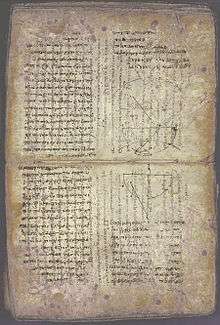On Floating Bodies

On Floating Bodies (Greek: Περὶ τῶν ἐπιπλεόντων σωμάτων) is a Greek-language work consisting of two books written by Archimedes of Syracuse (287 – c. 212 BC), one of the most important mathematicians, physicists, and engineers of antiquity. On Floating Bodies, which is thought to have been written around 250 BC, survives only partly in Greek, the rest in medieval Latin translation from the Greek. It is the first known work on hydrostatics, of which Archimedes is recognized as the founder.[1]
The purpose of On Floating Bodies was to determine the positions that various solids will assume when floating in a fluid, according to their form and the variation in their specific gravities. It contains the first statement of what is now known as Archimedes' principle.
History
Archimedes lived in the Greek city-state of Syracuse, Sicily. He is credited with laying the foundations of hydrostatics (which he established in On Floating Bodies), statics and calculating the underlying mathematics of the lever. A leading scientist of classical antiquity, Archimedes also developed elaborate systems of pulleys to move large objects with a minimum of effort. The Archimedes' screw underpins modern hydroengineering, and his machines of war helped to hold back the armies of Rome in the First Punic War. Archimedes opposed the arguments of Aristotle, pointing out that it was impossible to separate mathematics and nature and proved it by converting mathematical theories into practical inventions.
The only known copy of "On Floating Bodies" in Greek comes from the Archimedes Palimpsest.[2]
Content
First book
In the first part of the treatise, Archimedes establishes various general principles, such as that a solid denser than a fluid will, when immersed in that fluid, be lighter (this "missing" weight is found in the fluid it displaces). Archimedes spells out the law of equilibrium of fluids, and proves that water will adopt a spherical form around a center of gravity.[3] This may have been an attempt at explaining the theory of contemporary Greek astronomers such as Eratosthenes that the Earth is round. The fluids described by Archimedes are not self-gravitating, since he assumes the existence of a point towards which all things fall in order to derive the spherical shape. Most notably, On Floating Bodies contains the concept which became known as Archimedes' principle:
Any body wholly or partially immersed in a fluid experiences an upward force (buoyancy) equal to the weight of the fluid displaced
As well as the principle that bears his name, Archimedes discovered that a submerged object displaces a volume of water equal to the object's own volume (upon which it is said he shouted "Eureka"). Further, Proposition 5 of Archimedes' treatise On Floating Bodies states that:
Any floating object displaces its own weight of fluid.
This concept has come to be referred to by some as the principle of flotation.[3]
Second book
The second book is a mathematical achievement unmatched in antiquity and rarely equaled since.[1] The book contains a detailed investigation of the stable equilibrium positions of floating right paraboloids of various shapes and relative densities, when floating in a fluid of greater specific gravity, according to geometric and hydrostatic variations. It is restricted to the case when the base of the paraboloid lies either entirely above or entirely below the fluid surface. Archimedes' investigation of paraboloids was probably an idealization of the shapes of ships' hulls. Some of his sections float with the base under water and the summit above water, similar to the way that icebergs float. Of his works that survive, the second of his two books of On Floating Bodies is considered his most mature work, commonly described as a tour de force.[4]
References
- 1 2 "Archimedes (Greek mathematician) - Britannica Online Encyclopedia". Britannica.com. Retrieved 2012-08-13.
- ↑ Morelle, Rebecca (2007-04-26). "Text Reveals More Ancient Secrets". BBC News. Archived from the original on 19 February 2009. Retrieved 2009-03-31.
- 1 2 "The works of Archimedes". p. 257. Retrieved 11 March 2010.
Any solid lighter than a fluid will, if placed in the fluid, be so far immersed that the weight of the solid will be equal to the weight of the fluid displaced.
- ↑ "On Floating Bodies (Book II)". Math.nyu.edu. Retrieved 2012-08-13.